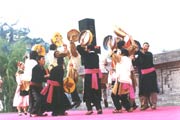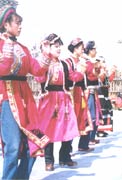| The time-honored Qiang bamboo flute with melodious sound
Because of the long history and the long closed-up living environment, many simple and pure old customs have been kept in the spiritual culture of the Qiangs. The two earliest literature forms are old poetry and myth in our country. These two forms of literature still have great influence in the local Qiangs till now, and many outstanding works have been passed on. Most of the Qiangs, men and women, young and old, can sing folk songs which are composed of 4 or 7 syllables for each sentence and is similar to the four-character verse or seven-character verse in Chinese. Speaking from the content, there are bitter songs, mountain songs, love songs, wine songs, jubilant songs and mourning songs. There are famous myths in the Qiangs, such as "the Creation of Heaven and Earth", "the Forming of Valleys and Plains", "Creation of Human Beings", "Dou'anzhu and Mujiezhu", etc. The stories about marriage between sister and brother and the shooting down of eight suns reflect indirectly the life of Qiangs in the primitive society.
 The most famous instrument of the Qiangs is nothing but the Qiang bamboo flute. Xushen wrote in "Explaining Words and Articles" in the Eastern Han: "The Qiang bamboo flute has three holes". It is said in "Long Bamboo Flute" written by Marong, "The recent double bamboo flutes come from the Qiangs". "Mixed Record of Folk Songs by the Music Bureau" records that "Bamboo flute is an instrument of Qiangs". The "Music Book" written by Chenyang in the Song Dynasty says, "The Qiang bamboo has five holes." It shows its long history. Of course, the Qiang bamboo flute has enjoyed good fame for long and its good reputation has spread widely. All these have relationship with the "Liangzhou (a place name) ci (poetry written to certain tunes with strict tonal patterns and rhyme schemes, in fixed numbers of lines and words)" which is a poetic masterpiece through the ages written by famous poet Wangzhihuan in the Tang Dynasty. "The Yellow River flows long as if it is among the clouds. There is a stretch of lonely city and a mountain with 10 thousand rens (an ancient measure of length that equals to seven or eight chis). The person who is blowing the Qiang bamboo flute shouldn't blame the willow, because the spring wind doesn't blow across the Yumen Pass. (It seems that there is no spring in the north out of the Yumen Pass)" This poem could be recited by children who just began to learn to read and write in the past. If poets of today could write more fine pieces about culture of ethnic groups that could be passed on, the poems must have played positive role in spreading and communication of culture among different nationalities. The Qiang flute that spreads in the Qiang region of Sichuan in modern times was made of bamboo or bone. The bamboo is a kind of oil bamboo, which grows at the upper reaches of the Minjiang River and is cut into square; the bone is leg bone of sheep or bird. The tube of present Qiang flute is 17 centimeters long and its diameter is 1 centimeter, which has one reed and two tubes. It has six scales, is played upright and is usually played in solo. The tone color is bright and gentle, aggrieved, sweet and agreeable, melodious and expressive. It is often played by shepherds in mountains. The old Qiang flute is not only an instrument but also a whip, so there is a saying---"blowing whip". The most famous instrument of the Qiangs is nothing but the Qiang bamboo flute. Xushen wrote in "Explaining Words and Articles" in the Eastern Han: "The Qiang bamboo flute has three holes". It is said in "Long Bamboo Flute" written by Marong, "The recent double bamboo flutes come from the Qiangs". "Mixed Record of Folk Songs by the Music Bureau" records that "Bamboo flute is an instrument of Qiangs". The "Music Book" written by Chenyang in the Song Dynasty says, "The Qiang bamboo has five holes." It shows its long history. Of course, the Qiang bamboo flute has enjoyed good fame for long and its good reputation has spread widely. All these have relationship with the "Liangzhou (a place name) ci (poetry written to certain tunes with strict tonal patterns and rhyme schemes, in fixed numbers of lines and words)" which is a poetic masterpiece through the ages written by famous poet Wangzhihuan in the Tang Dynasty. "The Yellow River flows long as if it is among the clouds. There is a stretch of lonely city and a mountain with 10 thousand rens (an ancient measure of length that equals to seven or eight chis). The person who is blowing the Qiang bamboo flute shouldn't blame the willow, because the spring wind doesn't blow across the Yumen Pass. (It seems that there is no spring in the north out of the Yumen Pass)" This poem could be recited by children who just began to learn to read and write in the past. If poets of today could write more fine pieces about culture of ethnic groups that could be passed on, the poems must have played positive role in spreading and communication of culture among different nationalities. The Qiang flute that spreads in the Qiang region of Sichuan in modern times was made of bamboo or bone. The bamboo is a kind of oil bamboo, which grows at the upper reaches of the Minjiang River and is cut into square; the bone is leg bone of sheep or bird. The tube of present Qiang flute is 17 centimeters long and its diameter is 1 centimeter, which has one reed and two tubes. It has six scales, is played upright and is usually played in solo. The tone color is bright and gentle, aggrieved, sweet and agreeable, melodious and expressive. It is often played by shepherds in mountains. The old Qiang flute is not only an instrument but also a whip, so there is a saying---"blowing whip".
 Local dances are "Shalang dance" (a kind of dance in circle of the Qiangs), "Armor dance", "Leather drum dance", "Langanshou" (transliteration), etc. The "Armor dance" is a kind of traditional customary sacrifice offering dance, and was often danced in officers' funerals that built outstanding military exploit. Tens of dancers wear raw ox hide armors, wear leather helmet inserted with pheasant's plumes and wheat skeleton, carry bronze bells on shoulders and hold weapons (mostly long sword). They separate into lines and dance like being poised in battle. The roar shakes heaven and they are full of power and grandeur, which expresses vividly and incisively the unyielding and unconstrained national characters and reproduces vividly the rough and simple ancient local traits. Local dances are "Shalang dance" (a kind of dance in circle of the Qiangs), "Armor dance", "Leather drum dance", "Langanshou" (transliteration), etc. The "Armor dance" is a kind of traditional customary sacrifice offering dance, and was often danced in officers' funerals that built outstanding military exploit. Tens of dancers wear raw ox hide armors, wear leather helmet inserted with pheasant's plumes and wheat skeleton, carry bronze bells on shoulders and hold weapons (mostly long sword). They separate into lines and dance like being poised in battle. The roar shakes heaven and they are full of power and grandeur, which expresses vividly and incisively the unyielding and unconstrained national characters and reproduces vividly the rough and simple ancient local traits.
Watchtowers standing loftily at the Southwest <<
The fragrant "sucking wine" with endless affection >>
|